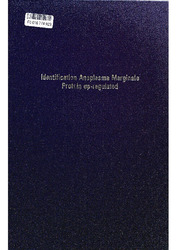| dc.contributor.author | Ramabu, Solomon Stephen | |
| dc.date.accessioned | 2022-01-12T09:18:14Z | |
| dc.date.available | 2022-01-12T09:18:14Z | |
| dc.date.issued | 2010-08 | |
| dc.identifier.uri | http://researchhub.buan.ac.bw:80/handle/123456789/95 | |
| dc.description.abstract | The transition between infection of the mammalian host and colonization of an arthropod vector is required for ongoing transmission of a broad array of pathogens, from viruses to protozoa. Understanding how this transition is mediated provides opportunities to disrupt transmission through either chemotherapy or immunization. We used two approaches to identify Anaplasma marginale proteins specifically up-regulated in the tick as compared to the mammalian host. We started with an unbiased proteome-wide screen to identify a list of candidates irrespective of localization within the bacterium or presumed function. Comparative mass spectrometric analysis of proteins separated by two- dimensional gel electrophoresis of uninfected and infected ISE6 cells and infected mammalian cells identified 15 proteins exclusively expressed or up-regulated in tick cells. All 15 had originally been annotated as hypothetical proteins. We confirmed quantitative up-regulation and expression in situ within the midgut epithelial and salivary gland acinar cells of vector ticks during successful transmission. The results support the hypothesis that A. marginale gene expression is regulated by the specific host environment and, in a broader context, that the core genome evolved in the arthropod vector with differential regulation allowing adaptation to mammalian hosts.
In the second part we used I predictive approach. We predicted based on the reported nuclear translocation of Anaplasma phagocytophilum AnkA and Erhlichia chaffeensis p200 that the expression of A marginale AnKA (AM705) would either be tick stage-specific or significantly upregulated in nucleated tick cells as compared to non-nucleated erythrocytes. In addition we predicted that AM705 would translocate to the host cell nucleus. We included in the analysis the other A. marginale genes with the ankyrin repeat motif; AM926 and AM638 While all the proteins were expressed in the tick stage, only AM638 was tick stage-specific. Contrary to our prediction the expression of AM705 was significantly higher in erythrocytes compared to ISE6 cells. AM926 was expressed at similar levels between ISE6 cells and erythrocytes. Using monoclonal antibodies specific to each protein in double immunofluorescence labeling we found that none of the proteins translocated to the host cell nucleus All these findings advance our understanding of pathogen mammalian host-tick vector transition. | en_US |
| dc.language.iso | en | en_US |
| dc.publisher | Washington State University | en_US |
| dc.subject | Anaplasma marginale proteins | en_US |
| dc.subject | Infection | en_US |
| dc.subject | Tick vector | en_US |
| dc.title | Identification of anaplasma marginale proteins up-regulated during infection of the tick vector | en_US |
| dc.type | Thesis | en_US |

